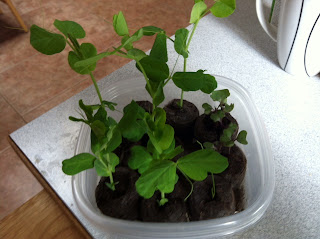 |
| first starts |
Spring comes late in the Pacific Northwest, with many false starts and broken promises. A bright, sunny day reaching toward temperatures in the seventies will be followed by an inch of snow or a bruising hail storm. The most reliable “last frost date” is around Mothers’ Day, so our growing season is brief and gardeners try to make the most efficient use of the growing time they do have. As a result, we are now in that seasonal limbo known as “indoor seed starting” that results from our illicit love affairs with seed catalogs. Lesser gardeners may prefer to wait for the seedlings to appear in garden shops, but the variety and provenance of these is limited. There is so much to know about new varieties that won’t fit on the little plastic tags that are inserted into the soil surrounding the garden-center plants, whereas the catalogs seduce us with the details of days to maturity, growth habits, and special characteristics of each type of seed. Seedlings from a store are o.k., but really, you don’t know how they’ve been treated or what they’re capable of.
 |
| "Scout the Destroyer" |
If you start your own seeds indoors, you can choose fewer plants of a larger variety of tomatoes or cucumbers, instead of committing to six of one type. Also, you can baby the tender ones indoors until the seasons have made up their minds. In my garden, the birds view those first seedlings as a salad bar placed for their convenience; the first green shoots hardly stand a chance. Plus there is the havoc that the paws of a 100-pound Labradoodle can wreak with one enthusiastic romp through the emerging rows. Because of these considerations, I now have rows of veggie starts lined up under a grow light like race horses in the starting gate, waiting for the first gunshot of spring.
 |
| Peat Pellets |
I like to use those dehydrated peat pellets because when they are soaked in warm water, they expand in a manner that reminds me of those Fourth of July tablets we would light on fire that produced twirling, writhing ashy “snakes” for our amusement. Of course, the peat pellets are not quite that dramatic. They just grow taller and mushy. They are easy to plant and I think it’s less disruptive for the seedlings’ roots to not be extricated from a pot. Repurposed clear plastic bakery trays work well as containers, and the lids can be closed to create a steamy little seed sauna for the first week or so until shoots appear. The trays tend to crack once the seedlings gain some weight, but they were trash anyway, right?
 |
| Seedlings under growlight |
Once the sprouts get some leaves, they should be placed outdoors (as the weather improves) for longer and longer periods of time to become acclimatized to wind, sun, and cooler temperatures. This is the process known as “hardening off.” The tricky part is remembering to bring them in before the sun gets too intense or the temperatures approach freezing. The sight of a sunburned cucumber plant is very sad, and I even had a couple of summer squash plants shrivel on a brisk morning even though their taller, sturdier siblings were fine. They did recover indoors under the grow light but it was a chilling (pun intended) reminder of what can happen.
So now, a month before Mothers’ Day, I’m going to set out some snow peas, Swiss chard, bok choy, and Chinese mustard because they are cold hardy and should tolerate the light frosts we will still get. Fingers crossed, but I also bought a “blanket” of row cover.
 |
| Ready to Plant! |
No comments:
Post a Comment